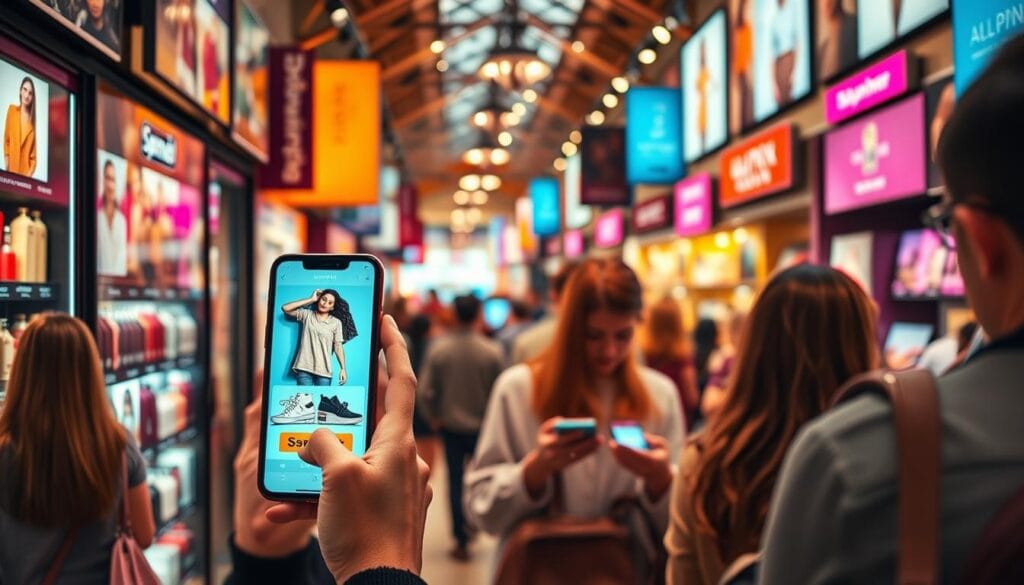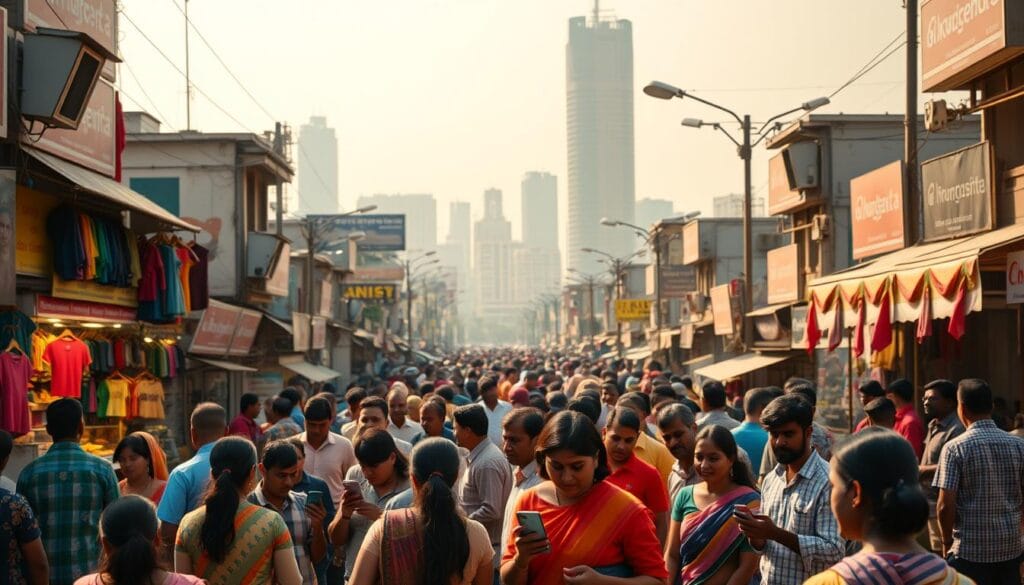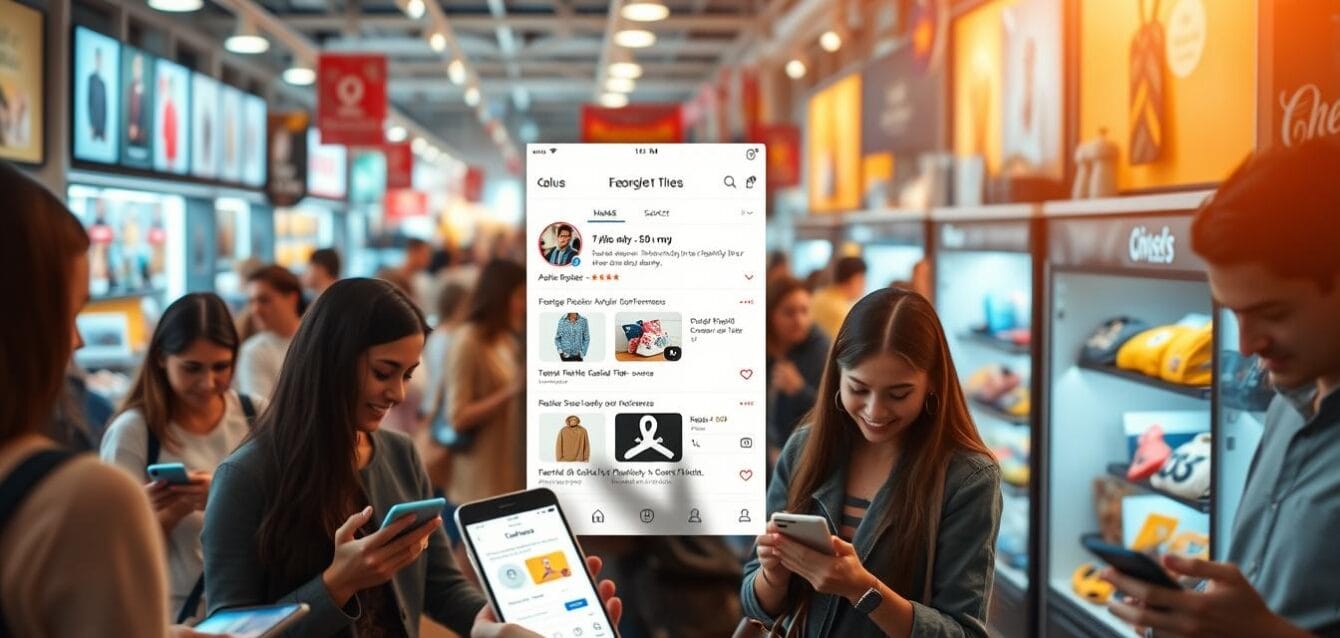86% of users who shop online in select markets say they’ve purchased through feeds —that shift from search to scroll is rewriting the rules for high-ticket brands.
We see a $8.42B market in 2025 poised for explosive growth. That scale means platforms now act as storefronts, not just discovery channels.
We guide premium brands to compress discovery, trust, and checkout into one seamless journey. Our playbooks cover content systems, platform-native checkout, attribution, and retention.
We partner with leaders to engineer repeatable lift: reduce friction with conversational selling, capture first-party customer signals, and align marketplace positioning to pricing and assortment.
Read on for the Growth Blueprint: exact tactics to lower CAC, raise LTV, and convert scrolls into predictable revenue. Contact us to accelerate execution and claim strategic advantage.
Key Takeaways
- Feeds have become direct sales channels; scroll-to-sale is the fastest path to conversion.
- High-ticket brands must build platform-native checkout and trust-first content systems.
- We provide a measurement blueprint to attribute every rupee and recycle winners.
- Value-led marketplaces and premium verticals need distinct pricing and assortment playbooks.
- Our Growth Blueprint pairs creative, checkout, and retention levers to scale ROI.
The shift from search to scroll: Why social media is becoming the new direct-to-customer sales channel
Buyer attention has migrated from search bars to endless feeds — and that migration rewrites how premium brands sell.
Thirty-seven percent of total online purchases are now influenced by social shopping, and live shopping, WhatsApp commerce, and creator-led buying are outpacing traditional marketplace growth.
We contrast the old search-and-buy funnel with the new scroll-and-convert reality: platforms own attention, and that attention now converts.

For high-ticket brands, the implications are clear: enable native checkout, trim flows to 1–2 clicks, and staff instant DMs. Every redirect compounds drop-offs for premium purchases.
- Design for moments: shoppable reels, live sessions, and creator storefronts that capture impulse and intent together.
- Real-time engagement: instant replies, preemptive FAQs, and guided choices to reduce buyer hesitation.
- Attribution-first: capture pixels and UTMs at source so spend reallocates to formats that drive measurable sales.
| Challenge | Platform Fix | Expected Outcome |
|---|---|---|
| High drop-off from redirects | Platform-native storefront + in-app checkout | Higher conversion rate, fewer abandoned carts |
| Slow response to high-value leads | Dedicated DM team and chat templates | Shorter decision cycles for expensive items |
| Poor attribution across feeds | Pixel events, UTMs, and catalog tagging | Accurate ROAS and scalable spend |
Action plan: map content to stages — discovery reels, comparative carousels, testimonial shorts, and DM-assisted closure. Reallocate budgets from generic ads to performance content with clear CTAs and in-app purchasing.
Outcome: more purchases inside the platform, lower friction across the buyer journey, and a dependable sales engine inside the scroll.
Defining social commerce and why it’s surging in India right now
We define social commerce as end-to-end buying that lives inside feeds and messaging apps — from first touch to checkout without a redirect. This model contrasts with traditional ecommerce, where discovery and purchase often live on separate sites.
From discovery to checkout inside platforms
In-platform buying blends influence, conversation, and transaction. Content-led discovery converts faster because creators and live demos cut research time for buyers.
Key strategic difference: ecommerce relies on search and product pages. Social commerce depends on trust signals, short-form demos, and one-click flows.
UPI, vernacular content, and creator ecosystems
UPI and integrated payments create a low-friction payment layer that scales trust for high-ticket purchases. Vernacular, video-first content unlocks broader reach and lifts conversion among regional users.
“Creator validation compresses the purchase cycle for premium products.”
- Platform-native tools: catalogs, live carts, and pinned FAQs shorten the path to purchase.
- Merchandising advice: build short demos, creator trials, and local-language FAQs to reduce hesitation.
- Operational tip: marry DM automation with guided selling for buyers who need confidence before checkout.
Outcome for premium brands: higher purchases, faster decisions, and measurable uplift when entry plays match product messaging to platform behavior in commerce india.
Social Commerce India: market size, growth drivers, and 2025 realities
We quantify the runway: the market reached $8.42B in 2025 and is on a 17.2% CAGR toward $54.3B by 2033.

491 million users engage with feeds, and 86% report purchases inside platforms. Flipkart (~$29B GMV), Amazon India (~$18–20B), and Reliance (~$5.7B) anchor the retail landscape.
Key numbers to know: users, GMV, and projected growth to 2033
Drivers: UPI ubiquity, creator trust, video-first content, and platform-native checkout compress intent into action.
Tier II/III shoppers, trust behaviors, and value-focused products
Tier II/III buyers seek value and social proof. Meesho (120M MAUs, >$5B run-rate) and Shopsy (100M users; 70% small cities) show unbranded, low-price SKUs scale fast.
For premium sellers: segment assortments, offer guarantees, optimize COD, and use creator demos to lift perceived value.
How quick commerce and ONDC intersect with social-led shopping
Quick commerce extends instant delivery to fashion and beauty. ONDC will standardize rails, improving discoverability and logistics for platform-led selling.
| Channel | Primary Advantage | Impact on sellers |
|---|---|---|
| Quick commerce | Faster delivery; higher frequency | Raises expectations; favors replenishable beauty/fashion SKU |
| Marketplaces | Scale & validation (Flipkart, Amazon) | Provides trust signal for first-time consumers |
| Open rails (ONDC) | Interoperability & visibility | Improves discoverability across commerce platforms |
- Segment SKUs: value units for volume; premium lines for margin.
- Offer clear credit and payment choices to reduce drop-offs.
- Combine social discovery, marketplace validation, and quick trials to de-risk entry.
Platform playbook: where brands, sellers, and shoppers convert today
We map which formats win on each platform and prescribe the exact mechanics that shorten decisions and lift AOV.
WhatsApp commerce: catalogs, conversational selling, and payments
Set up catalogs and guided scripts tied to payment links. Use the Business API for in-chat payments, broadcasts, and cart reminders. Automate FAQs and prioritize instant replies to reduce time-to-purchase.
Instagram, YouTube, and TikTok-style video
Tag products in Reels and Stories, run shoppable lives, and pin product modules in long-form reviews. Shorts and teasers create urgency; creator storefronts compress discovery to checkout.
Meesho, Shopsy, and GlowRoad
For mass-market reach, build value-led bundles and optimize titles, images, and reviews. Meesho (120M MAUs) and Shopsy (100M+ users) favor everyday fashion and beauty SKUs. Use GlowRoad reseller kits to expand geography quickly.
Facebook, Pinterest, and Snapchat
Deploy community groups, intent-led pins, and AR try-ons. Align these tools to planning behaviors and older demographics to drive store visits and considered purchases.
Outcome: map premium lines to visual platforms and value assortments to mass channels, keep store hygiene tight, and convert more shopping events in-platform.
Content that sells: live shopping, influencer commerce, and UGC designed for conversions
When we design shows that sell, viewers move from curiosity to checkout in one session.
Live shopping demands tight mechanics: time-bound offers, visible stock counters, and stacked proof—ratings, live comments, and repeat-buyer badges. Myntra’s ₹2 Cr hour on Instagram Live shows how limited-time drops convert intent into instant revenue.
Live shopping mechanics: urgency, social proof, and limited-time drops
Open with outcomes, demo the product, and trigger scarcity with countdowns and capped quantities.
Layer social proof: flash recent buys, show star ratings, and read short live reviews to shorten hesitation.
Micro-influencers vs celebrities: engagement, CAC, and ROI trade-offs
Micro-influencers deliver roughly 4X higher engagement and cost ~70% less than celebrities. We favor a diversified portfolio of 50–150 micro-hosts over a single celebrity to lower CAC and stabilize ROAS.
UGC, reviews, and creator-led demos for fashion, beauty, and home products
Plum Goodness scaled 4X revenue and cut CAC by 32% using 100+ micro-influencers and authentic skin-tone UGC. Encourage post-purchase uploads, run monthly UGC pulls, and incentivize reviews to build a compounding asset library.
Execution checklist:
- Script lives: open value, demo, handle FAQs, add bonuses, close with a time-bound CTA.
- Use creators to answer objections live and anchor perceived value for fashion and beauty items.
- Tie every asset to a conversion path—pinned carts, DM “buy now,” or native checkout links.
| Mechanic | Why it works | Typical Outcome |
|---|---|---|
| Limited-time drops | Creates urgency and FOMO | Higher conversion rate per session |
| Micro-influencer portfolio | Cost-efficient engagement | Lower CAC; steady ROI |
| UGC library | Authentic proof and content supply | Reduced creative spend; rising LTV |
Checkout, payments, and delivery: removing friction to drive sales and reduce RTO
Speed and certainty in payment and delivery are the last-mile levers for premium brands. We design checkout to convert intent into a completed purchase with minimal steps and maximum confidence.
One-click UPI, BNPL, and in-app checkout flows that convert
Enable one-click UPI and BNPL inside the app. Pre-fill address and payment preferences to cut form time.
The Souled Store reduced steps from five to two and lifted conversions 32%. Prepaid orders rose 19%, which lowered RTO.
Optimizing COD, prepaid incentives, and cart recovery via DMs
Keep COD but confirm via WhatsApp before dispatch. Offer a simple prepaid upgrade link in chat.
- Gentle prepaid nudges: small discounts or loyalty credit to shift behavior.
- Automated cart recovery DMs: image, stock alert, and time-bound incentive.
- Streamline forms to essentials and set default shipping speeds to match your promise.
Post-purchase on WhatsApp: tracking, support, and retention playbooks
Turn WhatsApp into the post-purchase nerve center. Deliver real-time tracking, SLAs, care tips, and reorder shortcuts.
53% of customers prefer WhatsApp tracking; brands using it see ~20% fewer refund requests. Lenskart raised repeat purchases by 27% using the same channel.
| Problem | Tactic | Expected Outcome |
|---|---|---|
| High drop-offs at payment | One-click UPI & BNPL; pre-filled data | Faster purchases; higher prepaid rate |
| Elevated RTO and NDRs | WhatsApp confirmation + flexible delivery windows | Lower RTO; fewer failed attempts |
| Abandoned carts | Dynamic DM recovery with limited offers | Recovered revenue; reduced CAC per sale |
Outcome: faster transactions, fewer cancellations, and delivery excellence that converts one-time buyers into loyal customers.
Measurement, governance, and trust: building an E-E-A-T-aligned social commerce engine
We build measurement rails that translate engagement into verifiable revenue and measurable brand trust.
First, we standardize tracking so every link and creative maps to outcomes. UTMs go on every outbound and in-app link. Pixel events are scoped by funnel stage and channel.
Next, capture first-party signals at every touch. Use lead forms in lives, DM opt-ins, and post-purchase enrollments. Feed those signals into an identity graph to power retargeting and LTV models.
Attribution across platforms: UTMs, pixel events, and first-party data capture
Adopt a blended approach: MMM for budget allocation and MTA for creative and funnel diagnostics.
- Cross-platform layer: standardized naming, channel-specific pixel events, and a common event schema.
- First-party capture: opt-ins at checkout, live-event leads, and chat-based enrollments.
- Close the loop: pipe engagement and users’ behavior into LTV models and lookalike audiences.
Content integrity: combating fake reviews and ensuring listing consistency
Content governance proves credibility and lifts conversion. Claim brand pages and lock product specs. Standardize images and pricing across commerce platforms.
| Governance Task | Tactic | Outcome |
|---|---|---|
| Fake reviews | Verified-purchase tags, audit trails, anomaly detection | Stronger trust signals; fewer fraudulent spikes |
| Listing drift | Weekly SKU audits, de-duplication, catalog syncs | Consistent discovery and fewer returns |
| Creator claims | Approved copy blocks and disclosure training | Lower legal risk; consistent messaging |
Maintain a public reviews and returns policy. Use moderation SLAs and realtime alerts for suspicious activity.
Outcome: cleaner attribution, higher trust for users, and a resilient ecommerce engine that protects brand value while scaling revenue.
Opportunities for U.S.-based brands: entering India’s social commerce market with confidence
U.S. brands can win fast by matching category fit to platform behavior and local buyer expectations.
We recommend starting where buyers are most receptive: fashion, beauty, and home. Premium products need stronger trust assets — demos, warranties, and creator validation.
Category fit, localization, and cross-border fulfillment
Localize offers: regional-language creative, India-specific bundles, and price points aligned to perceived value. Test tiered SKUs: value-led units for volume and premium lines for margin.
Clarify delivery commitments early. Use local 3PLs and pilot quick-delivery for fast-moving SKUs to lift conversions.
Partnering with platforms, creators, and marketplaces
Choose commerce platforms by goal: Instagram and YouTube for premium discovery; Meesho/Shopsy for volume; GlowRoad for reseller reach. Seed products with creators who build authentic reviews and evergreen content.
- Resolve compliance and taxes before launch.
- Offer COD with prepaid nudges and responsive WhatsApp support to build trust.
- Pilot use cases by cohort: urban premium launches vs. value drops for smaller cities.
| Goal | Best Channel | Expected Outcome |
|---|---|---|
| Premium positioning | Instagram / YouTube | Higher AOV; stronger brand equity |
| Volume & reach | Meesho / Shopsy | Fast purchases; broad penetration |
| Geographic expansion | GlowRoad / resellers | Scaled distribution; local trust |
Outcome: a focused entry blueprint that accelerates market entry, raises purchases, and secures a defensible presence across platforms.
Conclusion
The verdict is decisive: feed-driven selling is the fastest route from discovery to purchase. It pairs live shopping, creator proof, and native checkout to convert attention into revenue at scale.
We back this with clear wins — Myntra’s live drops, The Souled Store’s express checkout lift, and Lenskart’s WhatsApp retention play. These case studies prove the model works for premium fashion and beauty items.
Execution matters: native checkout, verified reviews, DM-assisted sales, and reliable delivery unlock compounding growth and repeat purchases.
Move fast. Run a 90-day pilot across two platforms with weekly lives, one-click payments, and WhatsApp post-purchase automation. Book Macro Webber’s Growth Blueprint today — limited onboarding slots each quarter for brands serious about 10X ROI.



